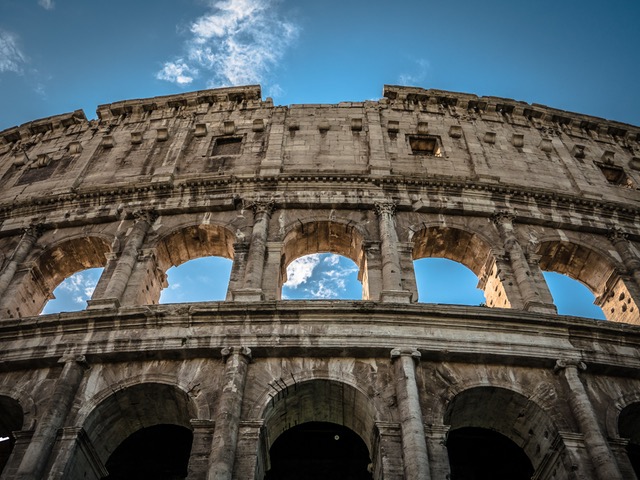Laura Sobbott Ross has been writing poetry since she was a teenager. Her writing has appeared in The Florida Review, Meridian, and many others. She was a finalist for the 2016 Newfound Anzaldúa Poetry Prize, as well as a finalist for the Pushcart Prize and the Arts & Letters Poetry Prize in 2016.
Ross occasionally reads poetry live, but says it is sometimes difficult for her to participate live poetry readings while living in a rural area. On the page, her work can be found in Newfound’s print issue No. 3. Her other poetry chapbooks include “A Tiny Hunger” from YellowJacket Press, and “My Mississippi” from Anchor & Plume Press.
The poetry in “The Graffiti of Pompeii” is inspired by the actual graffiti excavated from the site Pompeii is believed to have been located in Italy. The 26 poems in the collection are one part history lesson and many more parts creative imagining. The collection gives a voice to the ancient people of Pompeii, before the eruption of the volcano on Mount Vesuvius.
Ross got close to the supposed site of Pompeii several years ago, which is near Naples, Italy. There, Ross spent time on the Amalfi Coast but did not get to see the ruins of Pompeii–she chose her vacation spot before she had the idea for this chapbook.
Ross is a joy to talk to, especially when the topic is “The Graffiti of Pompeii.” She enjoys writing narrative poetry and prefers telling stories and sharing experiences that are actualized into meaning through images and emotion. “The Graffiti of Pompeii” does exactly this. Ross took actual found graffiti and brought it back to life by creatively and fictionally telling people’s stories through narrative poetry. She uses exceptional imagery and strong language to bring these stories to life, captivating every reader.
I marveled at the words and I wondered about the people who wrote them. -Laura Sobbott Ross
Megan Andreuzzi: You use very strong language and imagery like “she’d held the first fruits of the sons of Rome in her teeth more than once” and “they were sewn from the backs of their mothers’ eyelids.” These jump out at readers and make our imaginations run wild. I wanted to point to these two examples because they are quite haunting. What were you hoping to provoke from the readers? What do you feel from it? What are some of your favorite lines out of all the pieces?
Laura Sobbott Ross: That particular poem, about the prostitute named Attice, begins the series. The graffiti was meant to be a recommendation by a patron and was written on a bench at the Maritime gate, which was a main entrance into the city. What I felt was despair, layered beneath face paint, hunger, and her own power and powerlessness. The prostitutes were known as the “ninth hour girls,” meaning their business started nine hours after sunrise, so there was kind of a visual darkness and an internal one. “The stars brought anguish, a mirror of this dark city’s small burnings.” That poem was hard to shake. I wrote it first and put me in the mindset to write the others.
I like “Figulus loves Idaia” with its images of the fisherman in longing, the sweet and dizzy “Bees are like Lovers in That They Live a Honeyed Life,” and the pub poems: “Come and Drink with Us, Oceanus” – who was a famous gladiator of that era, and the feisty barmaid’s: “Whoever Wants to Serve Themselves Can Go on and Drink from the Sea.”
Andreuzzi: What inspired you to write “The Graffiti of Pompeii”?
Ross: I teach English to ESOL adults, and we were covering natural disasters. When it came to the word volcano, I mentioned Pompeii, and many had never heard of it. I found a video, without language, that showed what might have happened that day. It sparked an interest in me, and later through my own research, I found out about the graffiti of Pompeii. I was fascinated by it.
The graffiti that was unearthed was such a relatable sampling of humanity. Some of it was just everyday kind of stuff: Antiochus hung out here with his girlfriend Cithera, some of it was mischievous and funny, some sad and philosophical, and some of it was astoundingly poetic. I marveled at the words and I wondered about the people who wrote them. The volcano erupted in the first century A.D., and those unwitting historians told us so much in such aching plain speak, sometimes with a wink. I decided to try and flesh out the stories behind the writing, using both my imagination and information I’d gleaned through extensive research.
Andreuzzi: Where did you find the information for The Graffiti of Pompeii? In your author’s note, you mention it is from the excavated discoveries from Pompeii. Is this true? Tell me, was this actual found graffiti?
Ross: Indeed. There is so much graffiti which has been unearthed, and archeologists are continuing to find more. I did extensive research not only on the graffiti, but on Roman culture in the first century A.D. so that the poems would feel real and relevant. The citizens of Rome liked their wine watered down, but their fermented mullet sauce strong and on everything! Imagine the smell, especially since they used urine on their laundry.
Andreuzzi: Are the parenthesis in the title the location and the italicized text excerpts from graffiti?
Ross: Yes, and you can see from the variety of locations how the graffiti was written all over the city. Often, there were responses to what others had written, kind of like an ancient version of social media. There is even graffiti about graffiti: Oh walls, you have held up so much tedious graffiti that I am amazed you have not already collapsed in ruin.
Andreuzzi: Do you feel connected to any of the characters? Do any of them remind you of yourself? If so, which one(s)?
Ross: That’s an interesting question. I’d have to say none of them, or all – the village in my head! It was more important to me to get a good read on the characters behind the graffiti, and to have them fleshed out authentically, rather than leave any of myself behind. That being said, the one sounds most like me is the voice of the one standing at the window at night (x. House of Caecilius Iucundus), but I wouldn’t have thought about that until you asked me.
Andreuzzi: I can relate to the ‘village in my head’ sentiment. How long did The Graffiti of Pompeii take you to complete?
Ross: It took only about a month and a half. Once I got started, I just kept writing, before work, on work breaks, after work, on the weekends. I wanted to “lay down all the tracks” while I was in the same head space. I wrote twenty poems initially, and then added another six.
Andreuzzi: How did it feel when you were notified to be one of the finalists for the Anzaldúa Poetry Prize?
Ross: It was so exciting! The judges noted the quirky humor of the book, which was gratifying.
Don’t worry about what anyone else says or thinks about your words. Do what you love; do what inspires you. -Laura Sobbott Ross
Andreuzzi: You have other chapbooks published. Could you share a little from them?
Ross: (“My Mississippi” from Anchor & Plume Press is) collection of poems is a personal homage to a family history set in the Deep South. As with any family, there are stories, myths, and lullabies. The ones in these poems weave a complex backdrop to the flat and unforgiving dominion of the Delta. The land is both harsh and magical, a rural setting of bayous and blackberry thickets, and a vast horizon scored with distant latitudes and longitudes of pasture fences. Here, life is steeped slowly and spooned from a map of truths passed on like treasured recipe cards. There is hardship, triumph, and longing. Threading it is all like a collective vein, is the river. It’s what we know. It’s where we will return.
from the title poem “My Mississippi”:
“For every city, a river, blood
pact between land and water,
sharing what brothers would:
homestead, livestock, harvest, dreams.”
And from the poem “Full Moon” of A Tiny Hunger from YellowJacket Press:
“None of us could sleep.
Roofs and lawns opaline
between razored shadows.
Bald light unfolding pastures.
Ponds rife with surfacing fish.”
“Pale light striking–
a calibrated shaft.
Midwives swear by it,
when more babies are thrust
blue-white from the womb.
We all felt it and stirred,
cobwebbed beneath
our thread-counted sheets.”
Andreuzzi: Who are some of your favorite poets?
Ross: There are so many! It would be easier for me to say which journals I prefer: Disquieted Muses, Ruminate, Cold Mountain, Glass, and Earthshine is one in which I almost always discover a poem I want to keep forever. That being said, a couple of my favorite poets are Susan Elbe, and Yusef Komunyakaa.
Andreuzzi: What style of poetry do you enjoy reading?
Ross: I love poetry that is accessible, image-shimmered, but gritty, and full of light and shadow – meaning strong emotion; I’m drawn to that.
Andreuzzi: Do you have any advice for other poets?
Ross: Don’t worry about what anyone else says or thinks about your words. Do what you love; do what inspires you. Your voice is unique and necessary.
 Megan Andreuzzi is an animal lover and a traveler from the New Jersey Shore. She earned a degree from Arcadia University in Glenside, Pennsylvania, USA in Liberal Studies with a dual concentration in writing and a minor in theater.
Megan Andreuzzi is an animal lover and a traveler from the New Jersey Shore. She earned a degree from Arcadia University in Glenside, Pennsylvania, USA in Liberal Studies with a dual concentration in writing and a minor in theater.


0 comments on ““The Graffiti of Pompeii” – An Interview with Laura Sobbott Ross”